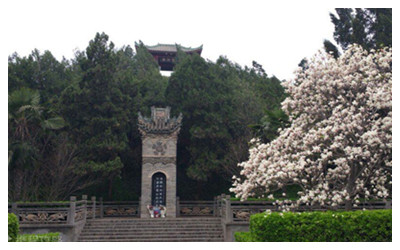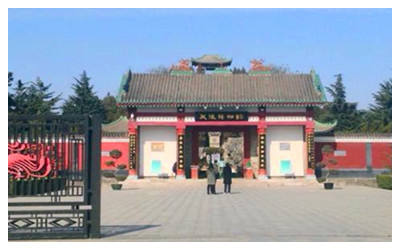Skype: neodalle-travel
Tel: +86 135 7447 2266
E-mail: sales@visitaroundchina.com
 Han Dynasty (206 BC-24AD) - Liu Che (157 BC - 87 BC).Maoling Mausoleum is also called ‘the Chinese Pyramid' since it is not only the largest but it also held the richest burial contents of all the mausoleums of Emperors constructed during the Western Han Dynasty (206 BC - 24 AD), and took the longest time, 53 years, to build.
Han Dynasty (206 BC-24AD) - Liu Che (157 BC - 87 BC).Maoling Mausoleum is also called ‘the Chinese Pyramid' since it is not only the largest but it also held the richest burial contents of all the mausoleums of Emperors constructed during the Western Han Dynasty (206 BC - 24 AD), and took the longest time, 53 years, to build.
Emperor Wu of Han-Liu Che
Liu Che was the fifth Emperor of the Western Han Dynasty (206 BC-24AD). He was a great feudal Emperor who can parallel Emperor Qin Shi Huang - the founder Emperor of the Qin Dynasty (221BC - 206BC). During his 54-year reign he exerted himself to make the country prosperous by consolidating and strengthening the unification of many nationalities. With his great talent, he made the Western Han Dynasty's power reach the highest peak and also opened the famous Silk Road.
What to see?
Han Emperor Wu's Tomb
Surrounded by the city wall, the cemetery is in its self quite square. The city wall is 431 meters long from east-to-west and 415 meters long from south-to-north. In the center of each wall there is a door. Now the ruins of east, west and north doors are still to be found in well preserved condition. The whole mausoleum is lofty and majesty. It is like a great cone in shape and even resembles a pyramid without its top. It is 46.5 meters high and the side length at the bottom, the widest part of the tomb is about 240 meters.
Maoling Museum
 According to historic records, the Emperor Wu used one-third of the taxes to build his tomb and it was filled with an abundant array of burial objects, many of which are now exhibited in Maoling Museum. Maoling Museum is built at the base of Maoling Mausoleum. In the museum, you will find sixteen grand stone carvings and cultural relics unearthed from Maoling Mausoleum, the Tomb of Huo Qubing and other attendant tombs.
According to historic records, the Emperor Wu used one-third of the taxes to build his tomb and it was filled with an abundant array of burial objects, many of which are now exhibited in Maoling Museum. Maoling Museum is built at the base of Maoling Mausoleum. In the museum, you will find sixteen grand stone carvings and cultural relics unearthed from Maoling Mausoleum, the Tomb of Huo Qubing and other attendant tombs.
Covering about 12 hectares, Maoling Museum combines the cultural relics and ancient structures with picturesque garden settings. There are symmetrical architectures of the Han Dynasty style, with a circular pond and a rockery in the central area and two exhibition halls displaying relics on both the western and eastern sides. Walk across the square and past the pond and then you will see the Tomb of Huo Qubing, which fronts the gate and is surrounded by sixteen stone carvings. Behind the tomb is a hill topped by a pavilion, which commands a great view of the whole museum and other attendant tombs nearby.
Tomb of Huo Qubing
Around Maoling Mausoleum, more than 20 tombs now still accompany Emperor Wu. Most of them are the tombs of imperial wives, meritorious ministers and worthy nobles. Here also to be found is the Tomb of Huo Qubing, which is much more famous for its magnificent stone carvings.
Huo Qubing (140 BC-117 BC) was a very outstanding and brave general in the Western Han Dynasty (206 BC-24). He and his uncle Wei Qing led the troops to repulse numerous incursions by the Huns and brought peace and prosperity to the society.
In 117 BC, he died at the age of 23, which was a great loss to the whole society. Emperor Wudi (156 BC-87 BC) and the entire nation felt very sad for this war hero's death, so the Emperor gave orders to hold a ceremonial funeral for him and built a spacious tomb for him just beside the Emperor's own. This is the present Tomb of Huo Qubing.
The Tomb of Huo Qubing lies 1,000 meters (about 1094 yards) northeast of Maoling Mausoleum , in Xingping City, Shaanxi Province. It is a cone-shaped soil and rock mound, adjacent to the Maoling Museum and is surrounded by a scenic environment.
Travel Tips
How to get there:
It takes about 2 hours from Xian to reach the Maoling Mausoleum by public transport.
Take a train to Xingping from Xian Railway Station, and then take Xingping Bus 11 to Maoling Bowuguan (Maoling Museum), which is about 1.2km (1,300 yards) east to Maoling Mausoleum.
Entrance Fee: CNY 80 ( The entrance ticket includes the museum and the mausoleum.)
Opening Hours: 08:00-17:30
 Ask Questions ?
Ask Questions ?